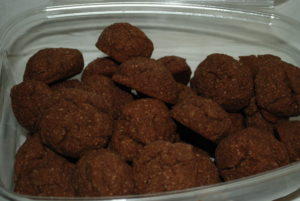Onward to new cookie horizons-
Fennel Seed is served raw or toasted as crunchy after dinner snacks in India based cuisine. They are digestive aids and have a breath freshening effect. The flavor is similar to licorice with a hint of mint lingering after the initial stronger flavor. I eat a small pinch or two equal to a half teaspoon or a teaspoon after meals as I have found it good for my digestion. Health benefits may also include bone strengthening protection against osteoporosis.
I’ve found that some people have a problem with foods that are too crunchy. The raw or toasted seeds are very crunchy. They are also available at speciality spice shops as a ground powder so when shopping for more Gumbo File Powder I also bought ground Fennel Powder – and the results are delicious. I returned to the original cookie variation that uses Golden Flaxmeal and Coconut Oil because I wanted the Fennel flavor to be the main flavor. The pomegranate adds a tangy distinct fruit background flavor which works with the stronger chocolate or molasses but might overpower the licorice mint flavor of Fennel seeds.
Several of the ingredients in addition to the Fennel Seed Powder may help promote our own production of Nrf2 which helps us make our own anti-inflammatory and possibly anti-cancer chemicals in addition to containing other beneficial phytonutrients.
Fennel Cookies:
Wet ingredients:
- 3 Tablespoons Golden Flaxmeal
- 10 Tablespoons boiling Water
- Stir the Flaxmeal into the boiling water in a small bowl for a couple minutes until it thickens and turns opaque slightly. Then add the melted Coconut Oil and stir until it turns creamy white and opaque. Then add the Brown Sugar, Vanilla, and Apple Cider Vinegar.
- 3/4 cup Coconut Oil, melted
- 1 cup Brown Sugar
- 1/2 teaspoon Vanilla
- 2 1/2 teaspoons Apple Cider Vinegar
Dry ingredients, mix together in a large bowl:
- 1 cup Brown Rice Flour
- 3/4 cup Coconut Flour
- 1/2 cup Tapioca Flour/Starch
- 1/2 cup ground Fennel Seed Powder
- 1/2 teaspoon Salt
- 3/4 teaspoon Baking Soda
Add the wet ingredients from the small bowl to the dry ingredients and stir gently until well mixed. The dough will be soft and sticky, moist enough to easily roll or spoon into small rounds. The batch makes two trays of 24 cookies about one inch around.
Coat the pans with a small amount of coconut oil or pan spray to prevent sticking. Bake at 350’F for 25-30 minutes. Rotate the pans from the top and bottom racks at 15 minutes. Let cool on a wire rack and then store in an airtight container in the refrigerator, freezer or at room temperature. Chilling in the refrigerator or freezer will convert the Tapioca starch into a form that can become a healthier form in the digestive system (called resistant starch).

Lime Cookies
*I tried a variation of this recipe and decided I liked the first batch best but after a couple days the flavor blended better and was also pretty good. Dried lime powder or dried lemon powder are available in Middle Eastern grocery stores. I used two tablespoons of dried lime powder instead of the half teaspoon of vanilla. The flavir blended into the cookie better after a couple days so it might work better if it were added to the melted coconut oil in advance of mixing the cookie dough – melt the oil, mix in the dried lime powder, stir and let it sit for ten or twenty minutes while measuring the other ingredients and then add it to the emulsified Flaxmeal.
The fennel powder could be replaced with more of one of the other flours or the flavor blended well after couple days and both the lime and fennel have anti-inflammatory phytonutrients content – so give it a try eithet way and maybe both would be enjoyable.
Disclosure: This information is being provided for educational purposes within the guidelines of Fair Use. While I am a Registered Dietitian it is not intended to provide individualized health care guidance.. Please seek an individual health care professional individualized health care guidance.




